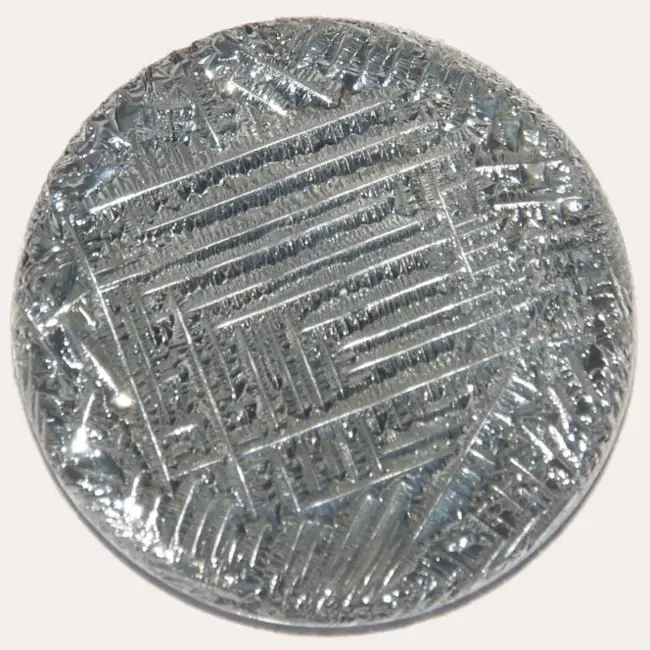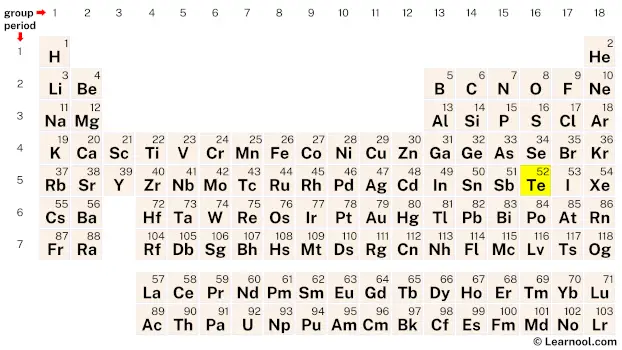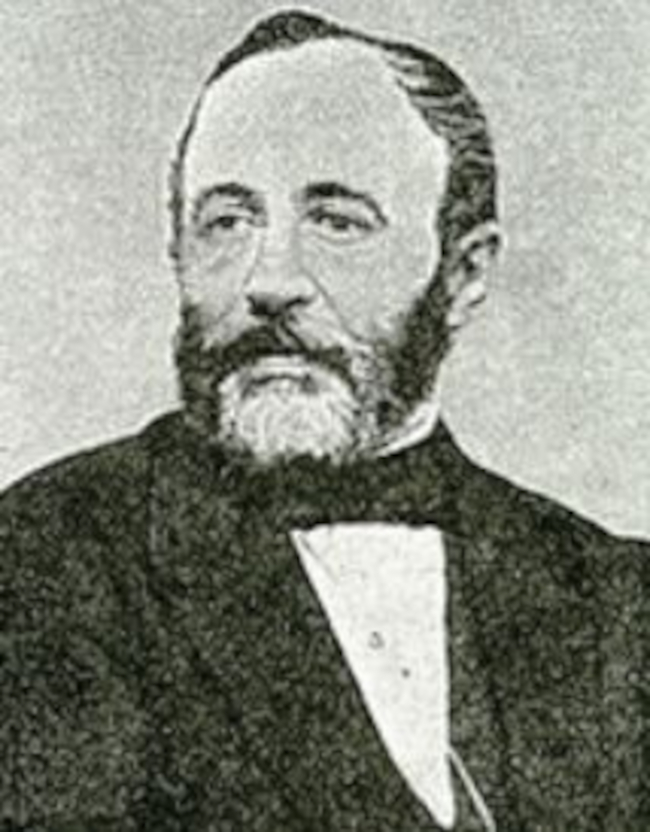
Tellurium (Te) is a chemical element of the periodic table, located in the group 16 and the period 5, and has the atomic number 52. It is a brittle, lustrous, silvery-white metalloid, whose name comes from the Latin word “tellus”, which means Earth. It is a member of the chalcogen group.
On periodic table
| group | ⇨ | 1 | 2 | 3 | 4 | 5 | 6 | 7 | 8 | 9 | 10 | 11 | 12 | 13 | 14 | 15 | 16 | 17 | 18 |
| period | ⇩ | ||||||||||||||||||
| 1 | 1 H  Hydrogen |
2 He  Helium |
|||||||||||||||||
| 2 | 3 Li  Lithium |
4 Be  Beryllium |
5 B  Boron |
6 C  Carbon |
7 N  Nitrogen |
8 O  Oxygen |
9 F  Fluorine |
10 Ne  Neon |
|||||||||||
| 3 | 11 Na  Sodium |
12 Mg  Magnesium |
13 Al  Aluminium |
14 Si Silicon |
15 P  Phosphorus |
16 S  Sulfur |
17 Cl  Chlorine |
18 Ar  Argon |
|||||||||||
| 4 | 19 K  Potassium |
20 Ca  Calcium |
21 Sc  Scandium |
22 Ti  Titanium |
23 V  Vanadium |
24 Cr  Chromium |
25 Mn  Manganese |
26 Fe  Iron |
27 Co  Cobalt |
28 Ni  Nickel |
29 Cu  Copper |
30 Zn  Zinc |
31 Ga  Gallium |
32 Ge  Germanium |
33 As  Arsenic |
34 Se  Selenium |
35 Br  Bromine |
36 Kr  Krypton |
|
| 5 | 37 Rb  Rubidium |
38 Sr  Strontium |
39 Y  Yttrium |
40 Zr  Zirconium |
41 Nb  Niobium |
42 Mo  Molybdenum |
43 Tc  Technetium |
44 Ru  Ruthenium |
45 Rh  Rhodium |
46 Pd  Palladium |
47 Ag  Silver |
48 Cd  Cadmium |
49 In  Indium |
50 Sn  Tin |
51 Sb  Antimony |
52 Te Tellurium |
53 I  Iodine |
54 Xe  Xenon |
|
| 6 | 55 Cs  Caesium |
56 Ba  Barium |
72 Hf  Hafnium |
73 Ta  Tantalum |
74 W  Tungsten |
75 Re  Rhenium |
76 Os  Osmium |
77 Ir  Iridium |
78 Pt  Platinum |
79 Au  Gold |
80 Hg  Mercury |
81 Tl  Thallium |
82 Pb  Lead |
83 Bi  Bismuth |
84 Po  Polonium |
85 At  Astatine |
86 Rn  Radon |
||
| 7 | 87 Fr  Francium |
88 Ra  Radium |
104 Rf  Rutherfordium |
105 Db  Dubnium |
106 Sg  Seaborgium |
107 Bh  Bohrium |
108 Hs  Hassium |
109 Mt  Meitnerium |
110 Ds  Darmstadtium |
111 Rg  Roentgenium |
112 Cn  Copernicium |
113 Nh  Nihonium |
114 Fl  Flerovium |
115 Mc  Moscovium |
116 Lv  Livermorium |
117 Ts  Tennessine |
118 Og  Oganesson |
||
| 57 La  Lanthanum |
58 Ce  Cerium |
59 Pr  Praseodymium |
60 Nd  Neodymium |
61 Pm  Promethium |
62 Sm  Samarium |
63 Eu  Europium |
64 Gd  Gadolinium |
65 Tb  Terbium |
66 Dy  Dysprosium |
67 Ho  Holmium |
68 Er  Erbium |
69 Tm  Thulium |
70 Yb  Ytterbium |
71 Lu  Lutetium |
|||||
| 89 Ac  Actinium |
90 Th  Thorium |
91 Pa  Protactinium |
92 U  Uranium |
93 Np  Neptunium |
94 Pu  Plutonium |
95 Am  Americium |
96 Cm  Curium |
97 Bk  Berkelium |
98 Cf  Californium |
99 Es  Einsteinium |
100 Fm  Fermium |
101 Md  Mendelevium |
102 No  Nobelium |
103 Lr  Lawrencium |
|||||
| – p block |
Tellurium is an p-block element, found in the sixteenth column and the fifth row of the periodic table. It has the atomic number 52 and is denoted by the symbol Te.
Element information
 |
|
 |
|
| Origin of name | Latin word “tellus” (which means Earth) |
| Symbol | Te |
| Atomic number (Z) | 52 |
| Atomic mass | 127.6 u |
| Block | p-block |
| Group | 16 (oxygen group) |
| Period | 5 |
| Classification | Metalloid |
| Atomic radius | 140 pm |
| Covalent radius | 138±4 pm |
| Van der Waals radius | 206 pm |
| Melting point | 449.51 ℃, 841.12 ℉, 722.66 K |
| Boiling point | 988 ℃, 1810 ℉, 1261 K |
| Electron configuration | [Kr] 4d10 5s2 5p4 |
| Learn how to write: Tellurium electron configuration | |
| Electrons per shell | 2, 8, 18, 18, 6 |
| Learn how to draw: Tellurium Bohr model | |
| Crystal structure | Trigonal |
| Phase at r.t | Solid |
| Density near r.t | 6.24 g/cm3 |
| Main isotopes | Tellurium-120, Tellurium-122, Tellurium-123, Tellurium-124, Tellurium-125, Tellurium-126 |
| Natural occurrence | Primordial |
| Oxidation state | -2, +2, +4, +6 |
| Electronegativity (Pauling scale) | 2.1 |
| Protons Neutrons Electrons |
52 76 52 |
| Valence electrons | 6 |
| Learn how to find: Tellurium valence electrons | |
| CAS number | 13494-80-9 |
| Discovered by | Franz-Joseph Müller von Reichenstein in 1782 |
History

Tellurium was discovered by Franz Joseph Müller von Reichenstein, an Austrian mineralogist, in 1782. He was studying a sample of a gold ore from a mine in Zalatna, Transylvania, and noticed a new element in the sample which he initially thought was antimony. In 1798, Martin Heinrich Klaproth, a German chemist, also discovered tellurium independently from a gold ore sample found in the mines of Zlatna in Hungary. He named the element after the Latin word “tellus” which means earth.
In the early 1800s, tellurium was used mainly as a coloring agent for ceramics and glassware. However, its rarity and high cost made it difficult to obtain in large quantities, limiting its use. It wasn’t until the mid-1900s that new applications for tellurium were discovered, and its use began to grow. Today, tellurium is an important element in several industries, including electronics, solar energy, and metallurgy.
Occurrence and production
Tellurium is a rare metalloid element that is mostly found in the Earth’s crust in the form of telluride ores. The most common tellurium minerals include calaverite, krennerite, sylvanite, and tellurite. It is usually obtained as a byproduct during the refining of other metals such as copper, gold, and lead.
Tellurium is produced commercially from several processes such as electrolytic refining of blister copper, electrorefining of crude lead bullion, and processing of anode slimes from the electrolytic refining of copper. It can also be extracted from waste streams of various industrial processes such as flue dust from smelters and wastewater from acid mine drainage. The main producers of tellurium are the United States, Canada, Peru, and Japan.
Properties
Tellurium is a brittle, silvery-white metalloid that belongs to the group of chalcogens in the periodic table.
It has a metallic luster but is easily oxidized in air, turning its surface a dull gray color.
It is a semiconductor, which means it can conduct electricity in certain conditions, but not as well as a metal.
Tellurium is a relatively soft element and has a Mohs hardness of 2.25.
It has a very low thermal conductivity, which makes it useful in some thermoelectric applications.
Tellurium has a very high boiling point of 449.51 ℃, which makes it useful in high-temperature applications.
It has a density of 6.24 g/cm3, which is slightly less than that of lead.
Tellurium is insoluble in water, but it does dissolve in concentrated sulfuric acid and nitric acid.
Tellurium has over 30 known isotopes, with some being stable like tellurium-120 and tellurium-123, while others are unstable and undergo radioactive decay.
Tellurium forms many compounds, including tellurides, oxides, halides, and acids.
Applications
Tellurium is used as an alloying agent with metals such as copper, stainless steel, and lead to improve their machinability and resistance to corrosion.
Tellurium is a critical component in the manufacturing of semiconductors for electronic devices such as solar cells, transistors, and thermoelectric devices.
Tellurium is used as a vulcanizing agent in the rubber industry.
Tellurium is used in the glass industry to produce colorless glass with high refractive index.
Tellurium is used as a catalyst in some chemical reactions.
Tellurium is used in the production of X-ray detectors for medical and industrial applications.
Tellurium is used in the production of thermoelectric materials for converting heat into electricity.
Tellurium compounds are used as flame retardants in plastics, textiles, and other materials.
Tellurium is used in the production of photographic toners and developer solutions.
Interesting facts
Tellurium is named after the Latin word “tellus,” which means earth.
It is the rarest stable solid element on Earth.
Tellurium has the unique ability to convert sunlight directly into electricity through the photovoltaic effect.
Tellurium actually has a relatively low melting point compared to many other metals, such as copper, iron, and aluminum. Its melting point is 449.51 ℃.
Tellurium can be used to make “metallic glasses,” which are extremely strong and resistant to wear and corrosion.
It is used in the production of blasting caps, as well as in the process of refining lead.
Tellurium is sometimes found in its native form in nature, but more commonly it is found in telluride minerals such as calaverite and krennerite.
When heated, tellurium emits a blue flame and gives off a garlic-like odor.
Tellurium has a unique property known as “metallicity,” which means that it exhibits both metallic and nonmetallic properties.
Tellurium has been used in some experimental cancer treatments due to its ability to disrupt cell metabolism.
Related
More elements
External links
- https://www.rsc.org/periodic-table/element/52/tellurium
- https://en.wikipedia.org/wiki/Tellurium
- https://www.britannica.com/science/tellurium
- https://pubchem.ncbi.nlm.nih.gov/element/Tellurium
- https://education.jlab.org/itselemental/ele052.html
- https://www.chemicool.com/elements/tellurium.html
- https://www.livescience.com/37396-tellurium.html
- https://www.radiochemistry.org/periodictable/elements/52.html
Deep
Learnool.com was founded by Deep Rana, who is a mechanical engineer by profession and a blogger by passion. He has a good conceptual knowledge on different educational topics and he provides the same on this website. He loves to learn something new everyday and believes that the best utilization of free time is developing a new skill.
